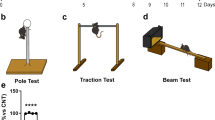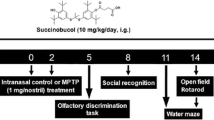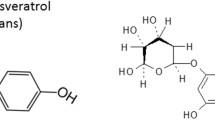Abstract
Administration of triacetyluridine (TAU) is a means of delivering exogenous pyrimidines to the brain, which may help to compensate for bioenergetic defects. TAU has previously been shown to be neuroprotective in animal models of Huntington’s and Alzheimer’s diseases. We examined whether oral administration of TAU in the diet could exert significant neuroprotective effects against 1-methyl-4-phenyl-1,2,3,6-tetrahydropyridine (MPTP) neurotoxicity model of Parkinson’s disease. Administration of TAU significantly attenuated MPTP-induced depletion of striatal dopamine and loss of tyrosine-hydroxylase-positive neurons in the substantia nigra. These findings suggest that administration of TAU may be a novel approach for treating neurodegenerative diseases associated with impaired mitochondrial function.
Similar content being viewed by others
References
Aussedat J. (1983) Effect of uridine supply on glycogen resynthesis after ischaemia in the isolated perfused rat heart. Cardiovasc. Res. 17, 145–151.
Beal M. F. (2001) Experimental models of Parkinson’s disease. Nat. Rev. Neurosci. 2, 325–334.
Beal M. F., Matthews R. T., Tieleman A., and Shults C. W. (1998) Coenzyme Q10 attenuates the 1-methyl-4-phenyl-1,2,3, tetrahydropyridine (MPTP) induced loss of striatal dopamine axons in aged mice. Brain Res. 157, 142–149.
Beuneu C., Auger R., Loffler M., Guissani A., Lemaire G., and Lepoivre M. (2000) Indirect inhibition of mitochondrial dihydroorotate dehydrogenase activity by nitric oxide. Free Radic. Biol. Med. 28, 1206–1213.
Connolly G. P. and Duley J. A. (1999) Uridine and its nucleotides: biological actions, therapeutic potentials. Trends Pharmacol. Sci. 20, 218–225.
Cornford E. M. and Oldendorf W. H. (1975) Independent blood-brain barrier transport systems for nucleicacid precursors. Biochim. Biophys. Acta 394, 211–219.
Forman J. H. and Kennedy J. (1975) Superoxide production and electron transport in mitochondrial oxidation of dihydroorotic acid. J. Biol. Chem. 250, 4322–4326.
Garcia R. A. G., Hu Z. Y., Liu L. S., Noble M., von Borstel R. W., and Saydoff J. A. (2002) Neuroprotective doses of PN401 that produce supraphysiological levels of uridine are greater than the dose of PN401 required to correct a pyrimidine deficiency. Soc. Neurosci. 27, 685.615.
Geiger A. and Yamasaki S. (1956) Cytidine and uridine requirement of the brain. J. Neurochem. 18, 93–100.
Hogans A. F., Guroff G., and Udenfriend S. (1971) Studies on the origin of pyrimidines for biosynthesis of neural RNA in the rat. J. Neurochem. 18, 1699–1710.
Horvath T. L., Diano S., Leranth C., et al. (2003) Coenzyme Q introduces nigral mitochondrial upcoupling and prevents dopamine cell loss in a primate model of Parkinson’s disease. Endocrinology 144, 2757–2760.
Kelsen D. P., Martin D., O’Neil J., et al. (1997) Phase 1 trial of PN401, an oral prodrug of uridine, to prevent toxicity from fluorouracil in patients with advanced cancer. J. Clin. Oncol. 15, 1511–1517.
King M. P. and Attardi G. (1989) Human cells lacking mtDNA: repopulation with exogenous mitochondria by complementation. Science 246, 500–503.
Lin Z., Richards S., Rosenfeldt F., and Pepe S. (1997) Uridine preserves ATP during hypoxic perfusion of the rat heart. Asia Pac. Heart 6, 190–196.
Loffler M., Jockel J., Schuster G., and Becker C. (1997) Dihydroorotate-ubiquinone oxidoreductase links mitochondria in the biosynthesis of pyrimidine nucleotides. Mol. Cell Biochem. 174, 125–129.
Matthews R. T., Ferrante R. J., Klivenyi P., et al. (1999) Creatine and cyclocreatine attenuate MPTP neurotoxicity. Exp. Neurol. 157, 142–149.
Saydoff J. A., Liu L. S., Garcia R. A. G., Hu Z., Li D., and von Borstel R.W. (2003) Oral uridine pro-drug PN401 decreases neurodegeneration, behavioral impairment, weight loss and mortality in the 3-nitropropionic acid mitochondrial toxin model of Huntington’s Disease. Brain Res. 994, 44–54.
Saydoff J. A., Liu L. S., Hu Z. Y., et al. (2001) Oral uridine Pro-drug P N 401 protects against azide toxicity in vivo: studies on the mechanism of uridine neuroprotection in vitro. Soc. Neurosci. 27, 2360.
Tieu K., Perier C., Caspersen C., et al. (2003) D-β Hydroxybutyrate rescues mitochondrial respiration and mitigates features of Parkinson disease. J. Clin. Invest. 112, 892–901.
Author information
Authors and Affiliations
Corresponding author
Rights and permissions
About this article
Cite this article
Klivenyi, P., Gardian, G., Calingasan, N.Y. et al. Neuroprotective effects of oral administration of triacetyluridine against MPTP neurotoxicity. Neuromol Med 6, 87–92 (2004). https://doi.org/10.1385/NMM:6:2-3:087
Received:
Revised:
Accepted:
Issue Date:
DOI: https://doi.org/10.1385/NMM:6:2-3:087




